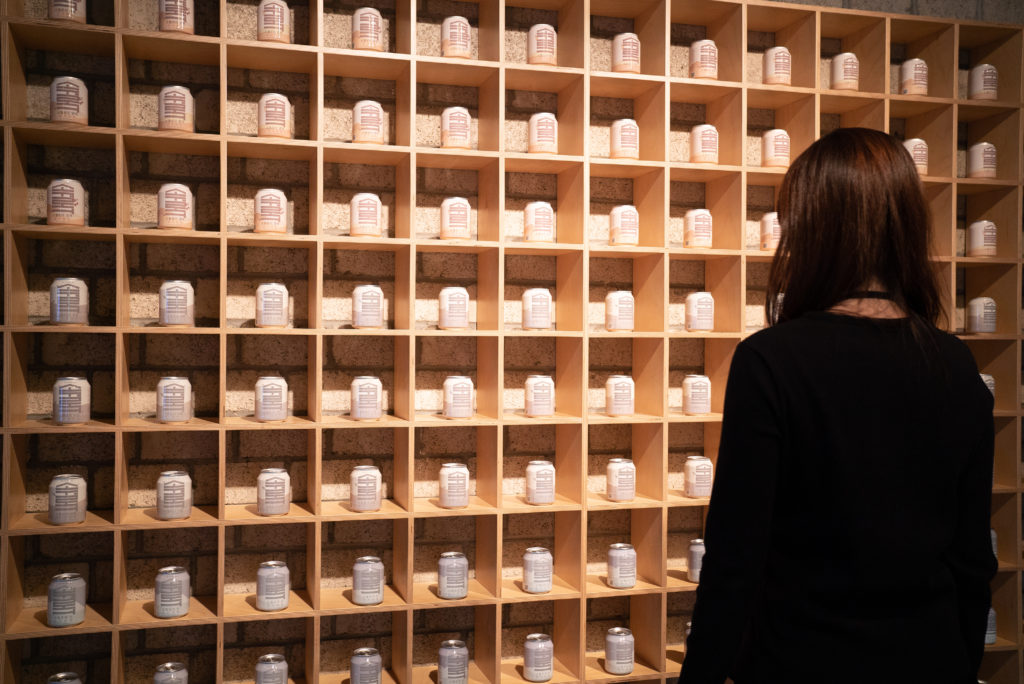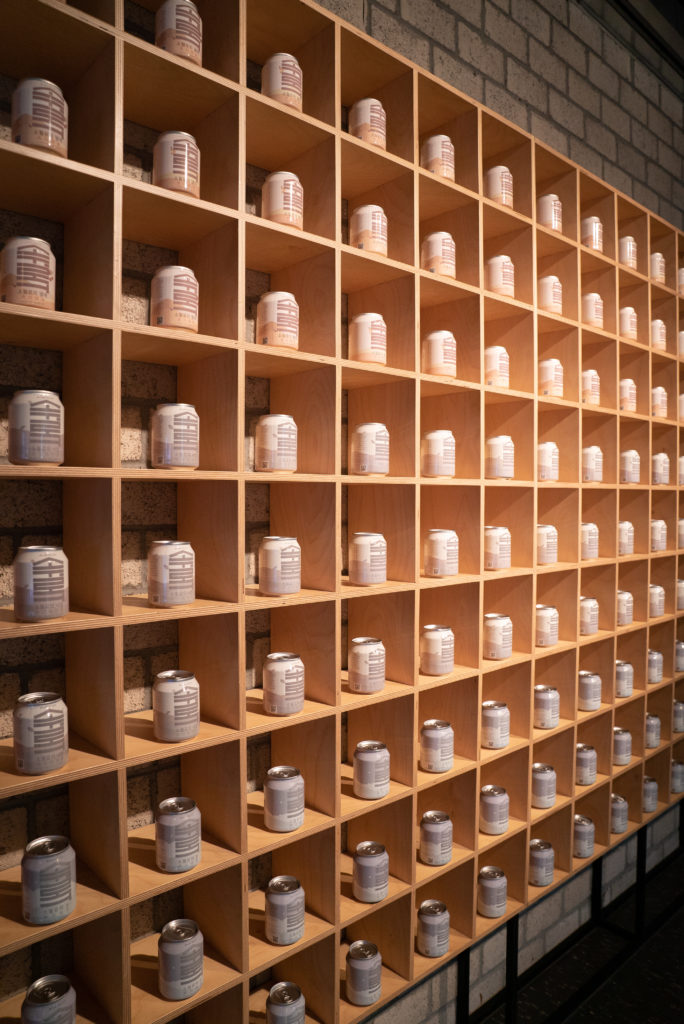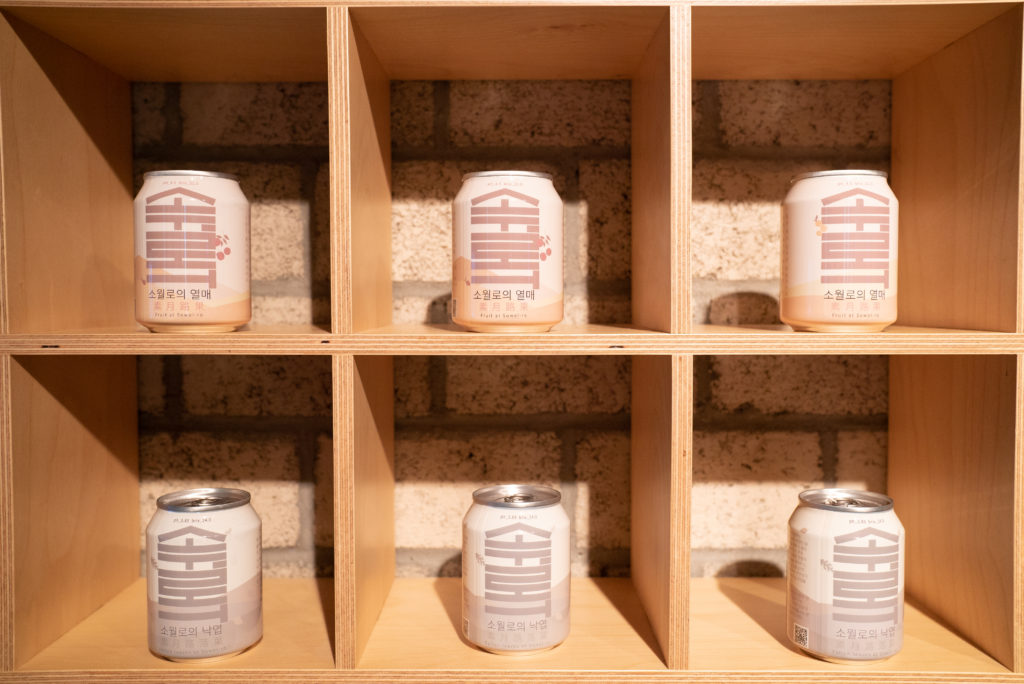by Erwan Jambet
Pour le numéro spécial « Vins & Spiritueux » du magazine Koï, ACA project a sélectionné des oeuvres qui lient art et alcool.
Créé dans le cadre du Nabi Open Lab 2020, A Glass at Sowol-ro [Un verre à Sewol-ro] est un makgeolli (alcool de riz) dont la recette est générée par une intelligence artificielle. Exposé en 2020 au Art Center Nabi, une institution dédiée à l’art contemporain et aux nouvelles technologies, il a été conçu par une équipe d’artistes et de scientifiques. Le nom fait référence à une rue du centre de Séoul, qui sépare le parc Namsan du quartier de Yongsan-gu.

Il en existe trois versions, Fruit à Sowol-ro, Feuilles mortes à Sowol-ro et Neige à Sowol-ro, présentées au sein de l’exposition dans des cannettes métalliques bien ordonnées sur de petites étagères en bois. Plus qu’un produit tangible, A Glass at Sowol-ro fait écho à un processus technologique et artistique, et à une « marque » utilisant une intelligence artificielle pour produire de nouveaux arômes personnalisés de makgeolli. Sangkwun Kang, ingénieur, a mis au point le modèle prédictif d’intelligence artificielle en s’appuyant sur des recettes traditionnelles, et le sommelier Dustin Wessa s’est chargé de la préparation du makgeolli. Deux artistes, Syemin Park et Hoseok Jung, étaient en charge des contenus web, du marketing, et de la scénographie de l’espace de dégustation.
Après avoir sélectionné une option, les visiteurs repartaient avec une canette de makgeolli dont le goût avait été déterminé par une recette générée par l’IA. L’approche scientifique, culinaire et artistique du collectif entendait « étendre le champ de la recherche esthétique du goût en s’éloignant des systèmes figés existants ». Le caractère évanescent de leur œuvre – est-ce de l’art ? est-ce une prouesse technologique ? est-ce une performance ? l’art s’évapore-t-il une fois la canette bue ? – lui confère une dimension quasi métaphysique, et interroge la manière dont nous produisons et consommons de l’art à l’aune du techno-capitalisme. Ou peut-être s’agit-il simplement d’une expérience de dégustation amusante et d’un nouveau regard artistique sur cette boisson traditionnelle.


For the latest issue of Koï magazine about « Wines & Spirits », ACA project has selected works linking art and alcoholic beverages.
Created at Nabi Open Lab 2020, « A Glass at Sowol-ro » is makgeolli (Korean rice wine), the recipe of which is generated by an artificial intelligence. Exhibited in 2020 at Art Center Nabi, an institution dedicated to arts and technology, it was created by a team of artists and scientists. The name refers to a road in central Seoul, between Namsan Park and Yongsan-gu.
Three different versions of the traditional Korean beverage (Fruit at Sowol-ro, Fallen leaves at Sowol-ro and Snow at Sowol-ro) were exhibited in cans disposed in an orderly manner on square wooden shelves. More than a final product, « A Glass at Sowol-ro » is a technological and artistic process, as well as a brand relying on AI to suggest personalized flavours of makgeolli according to the user’s preferences. While Sangkwun Kang, an engineer, oversaw the building of a predictive AI model based on data contained in ancient recipes, Korean liquor sommelier Dustin Wessa made the rice wine. Media artist Syemin Park created web content while fellow artist Hoseok Jung took care of the branding and the scenography of the tasting environment.
Visitors were able to select a taste of their choice and would be provided with a can of makgeolli whose flavour was based on the recipes generated by the AI model. Through their scientific, culinary, and artistic approach, the collective wished to “extend the range of aesthetic pursuit of taste by moving away from the fixed established system”. The evanescent aspect of their work – is it art? is it technology? is it a process? is it a performance? does the art vanish once the can of makgeolli has been drunk? – provides it with an almost metaphysical dimension, and questions how we produce and consume art in the age of techno-capitalism. Or it is, perhaps, just a fresh artistic take on a traditional drink and a fun makgeolli tasting experience.

